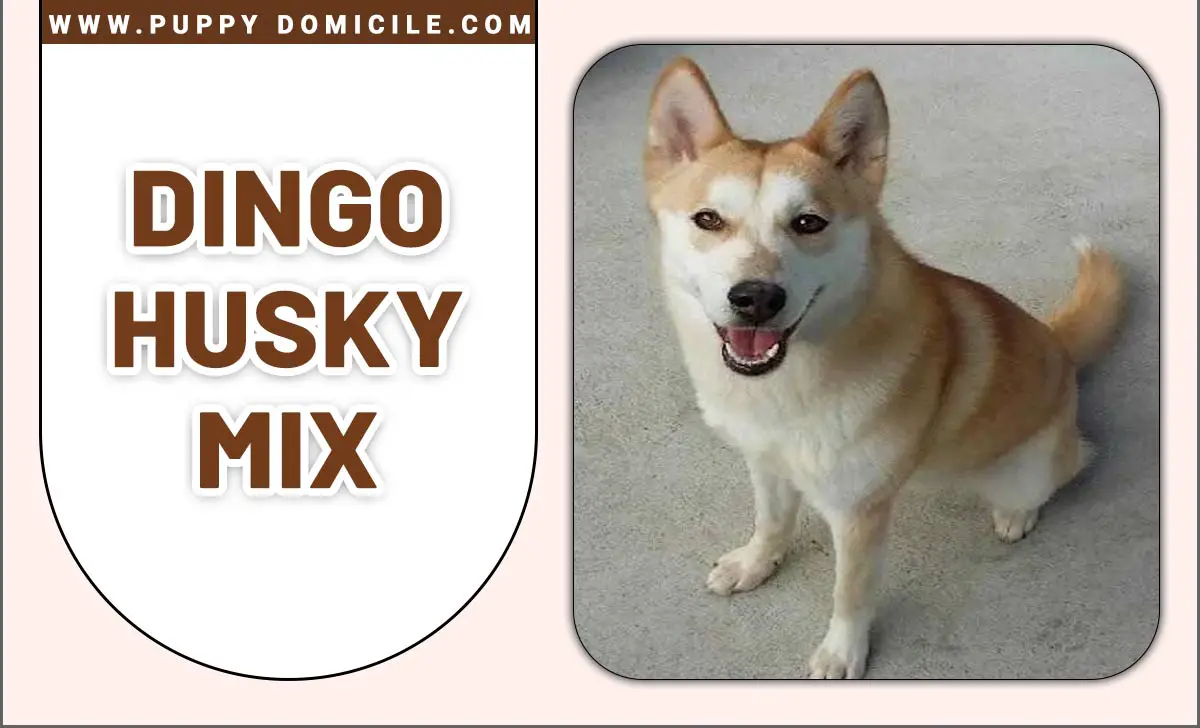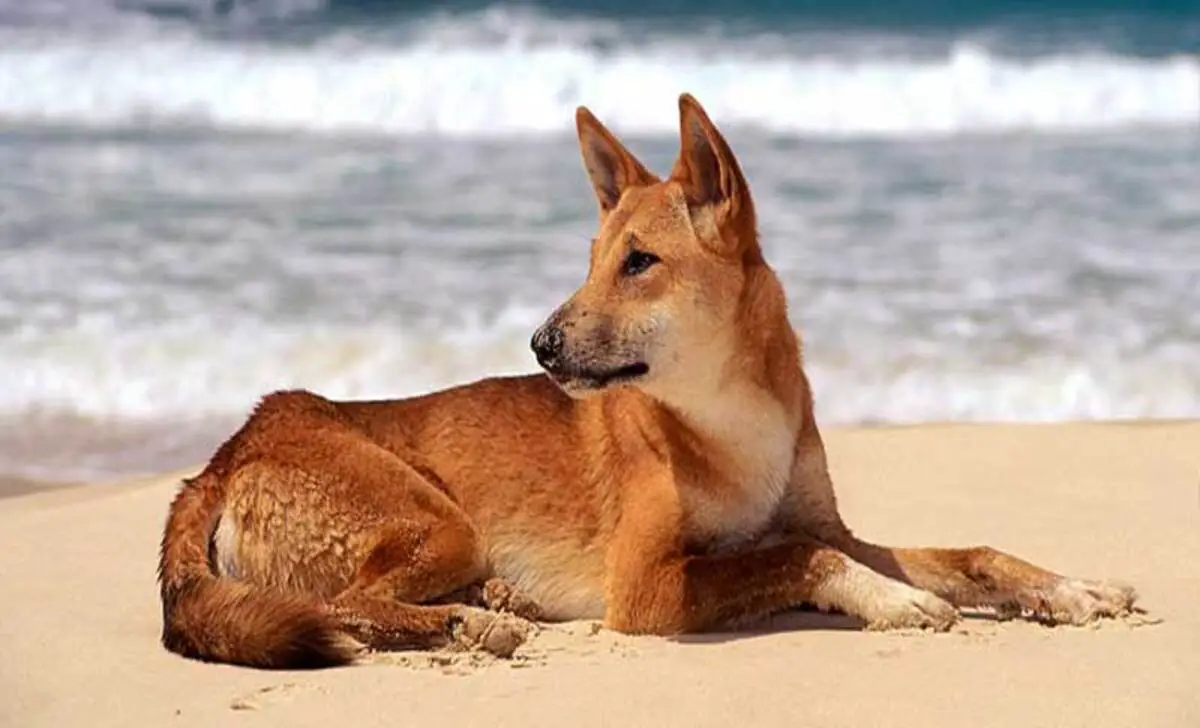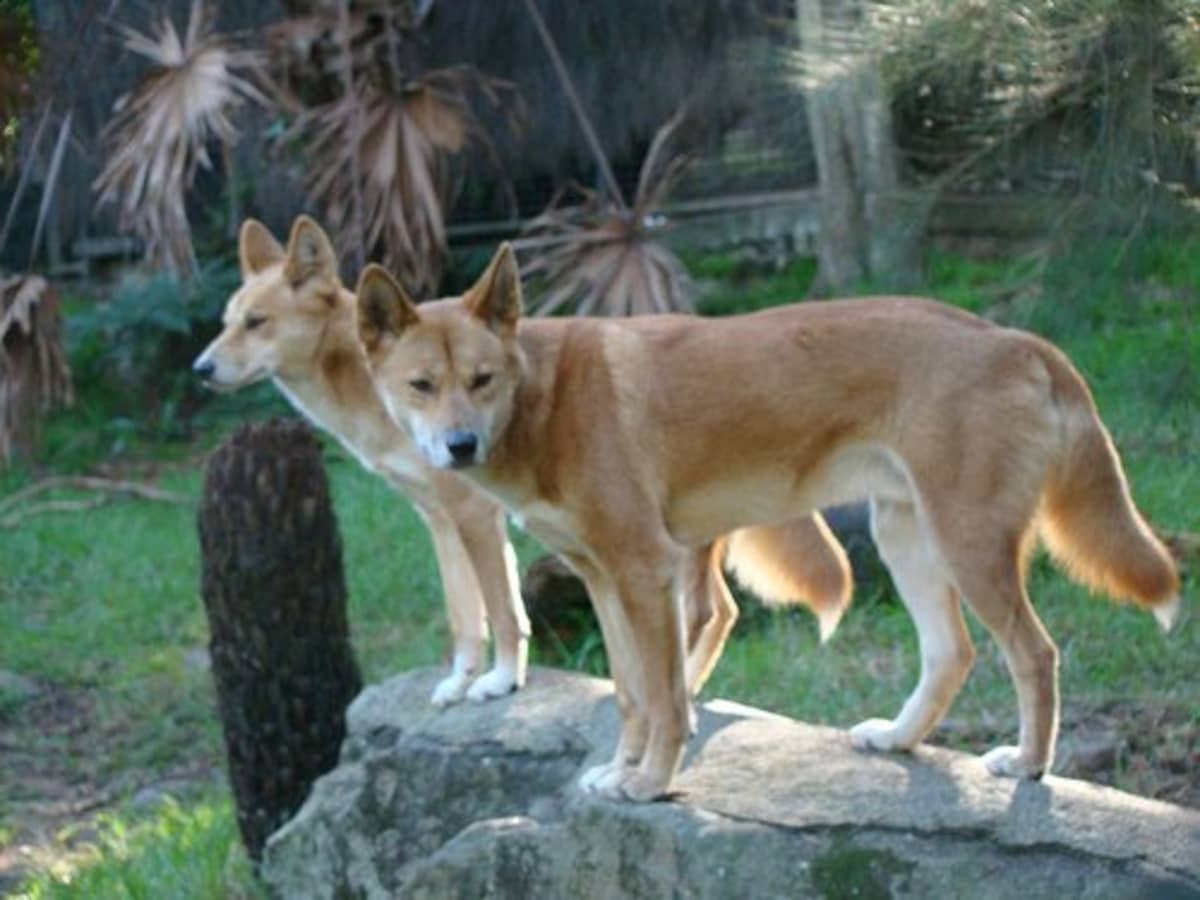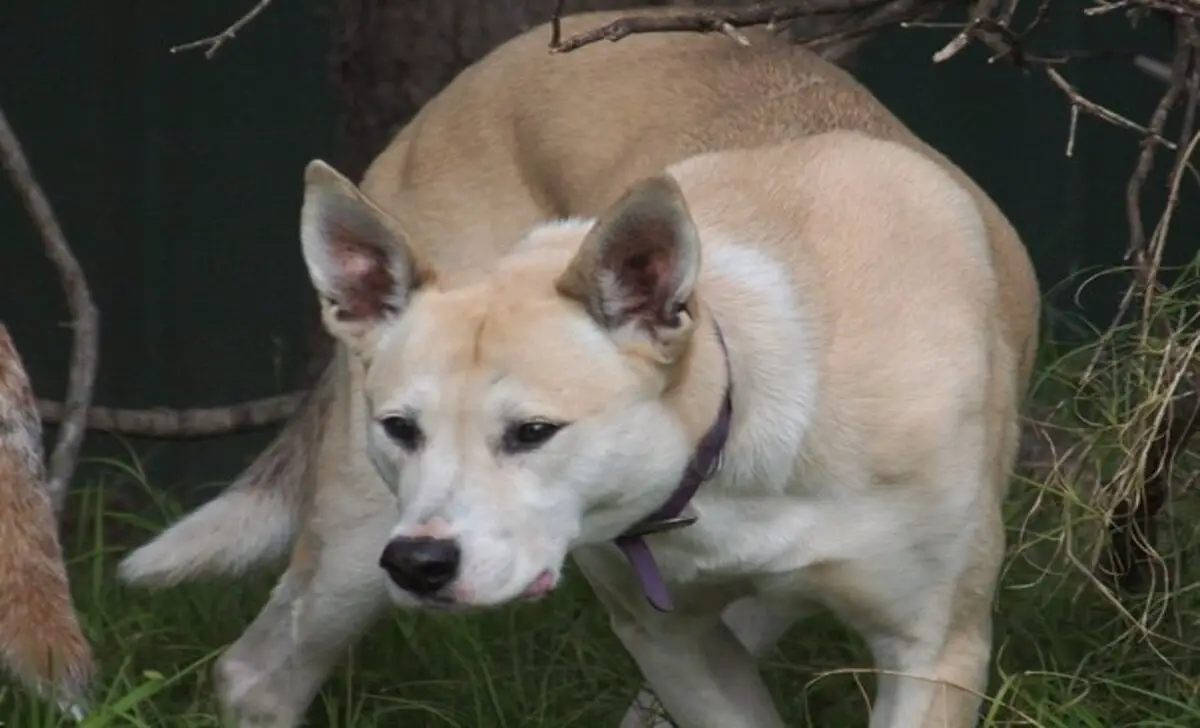Are you a dog lover intrigued by unique and fascinating breeds? If so, the Husky Dingo might pique your interest. This hybrid breed combines the dingo’s wild spirit with the husky’s friendly demeanor, resulting in a captivating furry friend.
A Dingo Husky mix is a hybrid breed resulting from the crossing of a Dingo, a wild dog native to Australia, with a Siberian Husky. This mix combines the Dingo’s natural instincts and agility with the Husky’s strength and sociable nature, resulting in a unique and potentially challenging companion.
In this overview, we’ll delve into the origins of the Husky Dingo, their physical characteristics, temperament, and any special care requirements they may have. So, if you’re curious about this enchanting breed and looking to add a hint of adventure to your life with a new canine companion, keep reading to discover all there is to know about the Dusky.

Physical Characteristics And Appearance Of A Dingo Husky Mix

Husky Dingo, also known as a Dixie Dingo, is a hybrid breed resulting from crossbreeding a domestic dog, such as a German Shepherd, with a Dingo. Originating from North America, these hybrids inherit physical characteristics from both parent breeds, resulting in a unique appearance.
They typically have a sturdy build with a wolf-like appearance, featuring pointed ears, a bushy tail, and a dense coat that can vary in color and pattern. Husky Dingoes are known for their intelligence, agility, and loyalty, making them excellent companions for active individuals or families. However, they may also exhibit strong prey drive and independent streaks inherited from their Dingo ancestry, requiring consistent training and socialization.
|
Trait |
Details |
|
Size |
Medium to Large |
|
Weight |
35-60 pounds |
|
Height |
18-24 inches |
|
Lifespan |
12-15 years |
|
Coat Type |
Double coat, dense and weather-resistant |
|
Coat Colors |
Varied (black, white, brown, gray, tan) |
|
Temperament |
Intelligent, energetic, independent, loyal |
|
Exercise Needs |
High (1-2 hours daily) |
|
Grooming Needs |
Moderate (weekly brushing, seasonal shedding) |
- Strong dog with wolf-like appearance
- Pointed ears and bushy tail
- Dense coat with various colors and patterns
- Intelligent, agile, and loyal temperament
- Strong prey drive and independent streak
Temperament And Behavior Traits Of A Dusky
A Husky Dingo’s temperament and behaviour traits can vary widely in terms of upbringing, socialization, and genetics. These hybrids may blend characteristics from both parent breeds, including intelligence, independence, and high energy levels.
Proper dog training and socialization are crucial for managing their instincts and energy. Potential adopters should research thoroughly and consider consulting with experts, especially in regions like South Carolina, where regulations on owning exotic or hybrid animals may apply.
Exercise And Training Needs For A Dusky

A Husky Dingo requires adequate exercise and training to maintain physical and mental well-being. This unique hybrid combines the wild instincts of a Dingo with the intelligence and energy of a Husky, making them highly active and independent. Daily exercises, such as long walks or runs, prevent boredom and destructive behaviours.
Additionally, mental stimulation through interactive toys and training sessions helps satisfy their intelligence and curiosity. Early socialization is crucial to prevent aggression towards other animals and strangers. Consider adopting from shelters or rescue organizations to provide a loving home for these often misunderstood pariah dogs. While not recognized by the American Kennel Club, Husky Dingoes make loyal companions for experienced dog owners willing to commit to their specialized needs.
- Daily exercise requirements, such as long walks or runs
- Mental stimulation through interactive toys and training sessions
- Early socialization to prevent aggression
- Consider adoption from shelters or rescue organizations
Grooming Requirements For A Husky Dingo
A hybrid of the Dingo and Husky breeds, this mix inherits qualities from both parents, including their thick double coat that sheds seasonally. Regular grooming is essential to maintain their coat’s health and prevent matting. Brushing them weekly helps to remove loose fur and reduce shedding.
Additionally, bathing should be done occasionally to keep their skin and coat clean. Due to their active nature, their nails should be trimmed regularly to prevent overgrowth. Proper dental care is also crucial for their overall health. Building a strong bond with your Husky Dingoes through love, training, and socialization will ensure a happy and healthy relationship with your furry companion.
|
Grooming Task |
Frequency |
|
Brushing |
2-3 times per week |
|
Bathing |
Every 6-8 weeks |
|
Nail Trimming |
Every 3-4 weeks |
|
Ear Cleaning |
Weekly |
|
Teeth Brushing |
2-3 times per week |
|
Eye Cleaning |
As needed |
|
Coat Trimming |
As needed |
|
Skin Check |
During brushing sessions |
|
Grooming Needs |
Moderate (weekly brushing, seasonal shedding) |
Health Considerations And Common Issues In Dingo Husky Mix Breeds

Common health concerns in Dinguskyes include hip dysplasia, progressive retinal atrophy, and allergies. Regular vet check-ups, a balanced diet, and plenty of exercise are crucial to ensure their well-being. Regarding domestic dogs, pet adoption is a great way to provide a loving home to needy animals. When adopting a Husky Dingo or any other pet, it is important to consider their specific needs and provide a safe environment for them to thrive.
- Regular vet check-ups are essential to monitor their health and address any issues promptly.
- A balanced diet tailored to their nutritional requirements can help prevent health problems.
- Providing ample exercise and mental stimulation is key to keeping Dinguskyes happy and healthy.
- Pet adoption gives animals a second chance at a loving home and promotes responsible pet ownership.
Feeding Guidelines And Dietary Needs For A Dingo Husky Mix
When caring for a Dingo Husky Mix, paying attention to their dietary needs and feeding guidelines is essential. This unique mix of breeds typically requires a diet that is high in protein to support their active lifestyle. A balanced diet consisting of high-quality dog food specifically formulated for medium to large breeds is recommended. Additionally, it is important to monitor their food intake and adjust portion sizes accordingly to maintain a healthy weight.
|
Nutrient |
Sources |
Daily Amount |
|
Protein |
Chicken, turkey, fish |
25-30% of daily diet |
|
Fat |
Salmon oil, flaxseed |
10-15% of daily diet |
|
Carbohydrates |
Brown rice, quinoa, sweet potatoes, green beans |
30-40% of daily diet |
|
Fruits |
Blueberries, apples, bananas |
5-10% of daily diet (in small servings) |
|
Supplements |
Glucosamine, chondroitin |
As recommended by a veterinarian |
|
Water |
Fresh, clean water |
Always available |
Conclusion
The Dingusky offers a fascinating blend of traits from the Australian Dingo and the Siberian Husky, creating a one-of-a-kind companion that is both intelligent and full of energy. This unique hybrid breed showcases a striking appearance and a lively personality that can make for a beautiful addition to any family.
With their intelligence and power, Duskyes will bring their owners joy and excitement while standing out with their distinct features. Whether you’re looking for a loyal pet or an active partner for outdoor adventures, the Dusky could be the perfect choice.
Frequently Asked Questions
1.How Do I Know If My Dog Is A Dingo?
To tell if your dog is a dingo, look for physical traits such as a short, yellowish-brown coat, pointed ears, a bushy tail, a broad head, and a lean body. Observe your dog’s behaviour as well; dingoes are known for their independent nature and strong hunting instincts.
2.Is The American Dingo A Good Pet?
The American Dingo can be a wonderful pet for the right owner. They are intelligent, loyal, and active dogs that require plenty of exercise and mental stimulation.
3.What Dog Breed Is Closest To A Dingo?
The Carolina Dog, also known as the American Dingo, is the dog breed closest to a Dingo. Dingoes and Carolina Dogs are considered primitive breeds with similar physical and behavioural characteristics.
4.Which Dog Breed Did The Native Americans Domesticated?
The Native Americans domesticated several dog breeds, including the Alaskan Malamute, Siberian Husky, Inuit pup, Salish Wool Dog, Carolina Dog, and American Indian Dog.
5.How Can I Use A Dusky To Help My Dog’s Behaviour?
Providing proper socialization and training is important to help with your Dusky’s behaviour. This active breed requires plenty of exercise and mental stimulation to stay healthy and happy.
6.What Dog Is Closest To A Dingo?
The Carolina Dog, also known as the American Dingo or Dixie Dingo, is considered the closest living relative to the dingo. This primitive breed shares many physical and behavioural traits with its wild ancestor.
7.What Are The Differences Between A Dingo And A Dog?
While dingoes and dogs share a common ancestry, there are notable differences. Dingoes are wild canids native to Australia, characterized by their lean build, pointed ears, and yellowish or reddish coat. They exhibit pack behaviour and are skilled hunters. On the other hand, domestic dogs come in various breeds developed through selective breeding for specific traits and purposes, with wide variations in size, coat type, and behaviour.
8.Can An American Keep A Dingo As A Pet Legally?
Laws regarding pet ownership vary by state in the United States. While some states may permit keeping dingoes as pets, many have strict regulations due to concerns about their wild nature and potential danger to humans and domestic animals. Researching local regulations and obtaining any necessary permits or licenses before considering a dingo as a pet is essential.
9.Can A Dingo Raised From A Puppy Be Tamed Like A Dog?
While dingoes raised from a young age may form bonds with humans, their wild instincts remain deeply ingrained. While some individuals may exhibit more docile behaviour, dingoes retain their independent and predatory nature. Proper socialization and training can mitigate some of these behaviours, but they may still display traits not typically seen in domestic dogs.
